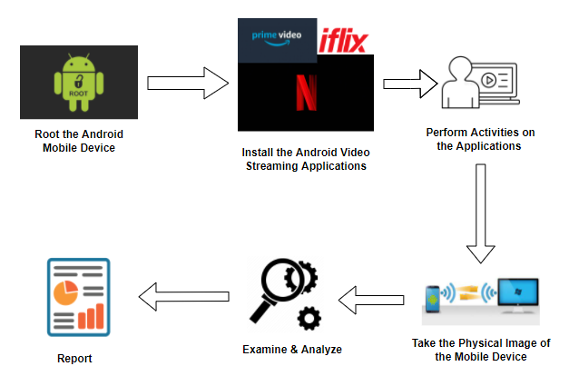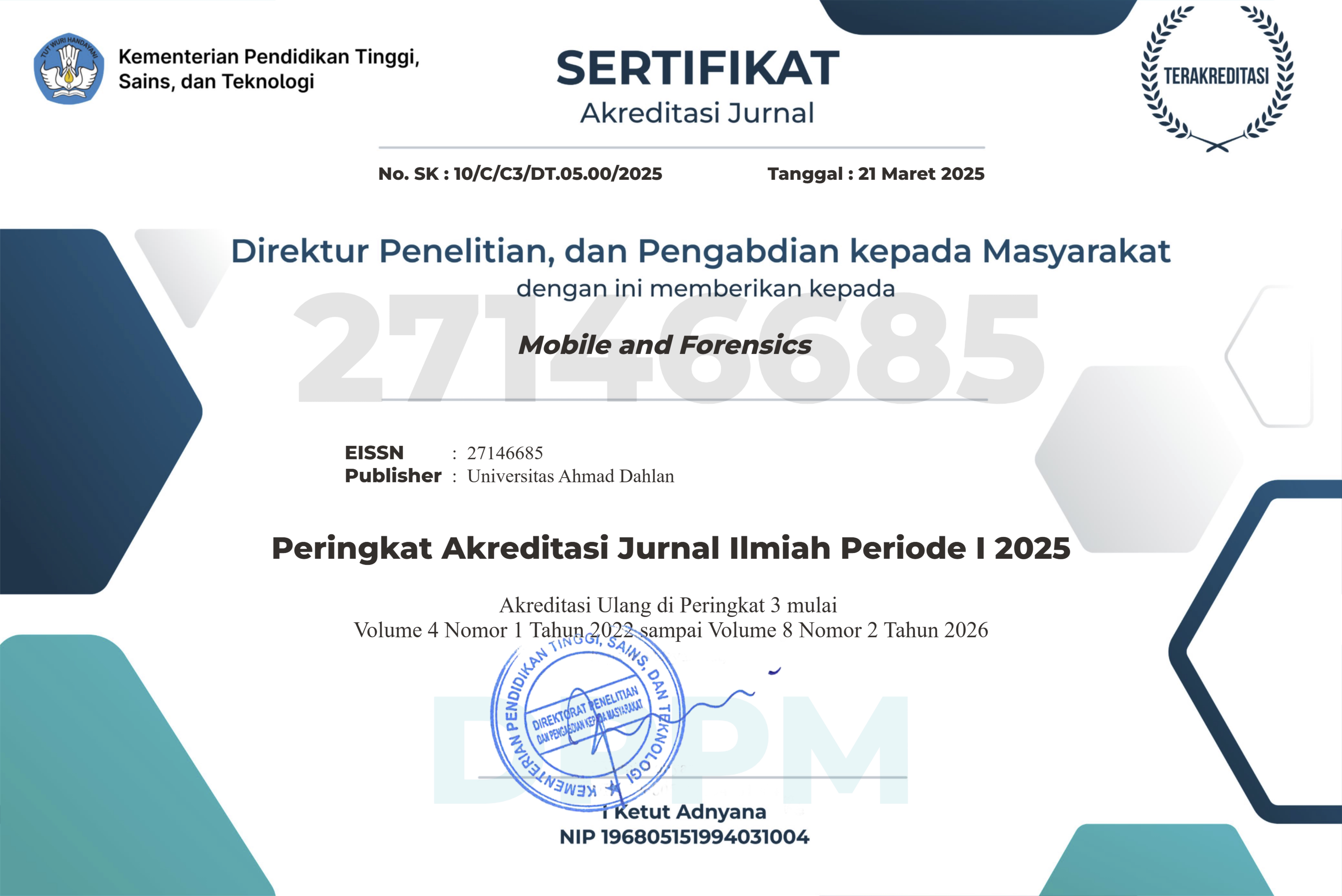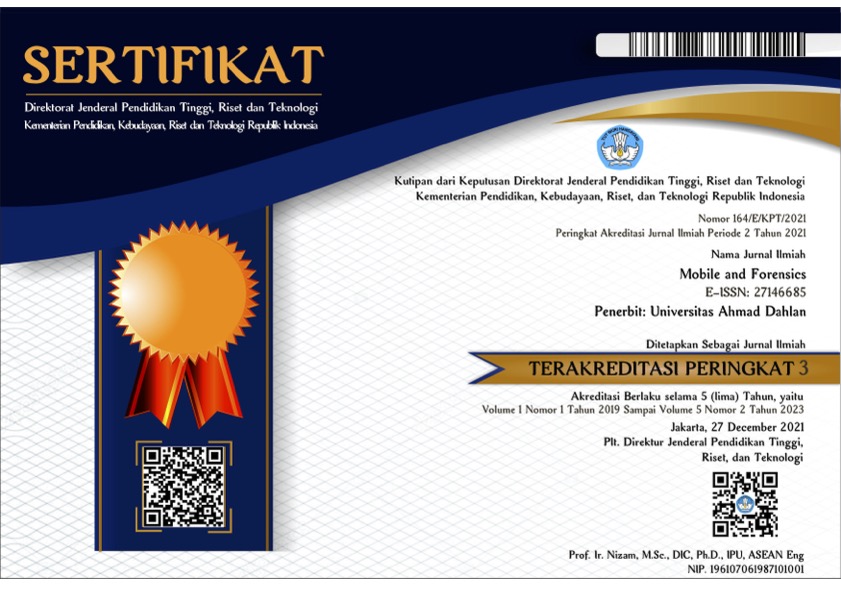A Forensic Analysis of Video Streaming Activities on Android Applications
DOI:
https://doi.org/10.12928/mf.v4i1.5762Keywords:
Mobile Forensics, Video Streaming Platforms, Autopsy, Netflix, AndroidAbstract
Mobile applications of video streaming platforms store a lot of information on mobile devices which can have both positive and negative impacts. Positive, in the sense that it could assist law enforcement agencies in solving crime, and the negative impact is that it could be accessed by malicious actors. In this study, we forensically investigate the Netflix, Amazon Prime Video, and iFlix android applications. The major focus is on identifying stored artifacts on the mobile devices left behind by the android video streaming applications. It will give law enforcement agencies and forensic investigators a clear direction when it comes to extracting evidence to solve a crime. On the other hand, it will notify the mobile application developers on how to further improve the security of their mobile applications.
References
T. Hermawan, Y. Suryanto, F. Alief, and L. Roselina, ‘Android Forensic Tools Analysis for Unsend Chat on Social Media’, in 2020 3rd International Seminar on Research of Information Technology and Intelligent Systems (ISRITI), Yogyakarta, Indonesia, Dec. 2020, pp. 233–238. doi: 10.1109/ISRITI51436.2020.9315364.
A.-S. T. Olanrewaju, M. A. Hossain, N. Whiteside, and P. Mercieca, ‘Social media and entrepreneurship research: A literature review’, International Journal of Information Management, vol. 50, pp. 90–110, Feb. 2020, doi: 10.1016/j.ijinfomgt.2019.05.011.
C. Ruiz-Mafe, E. Bigné-Alcañiz, and R. Currás-Pérez, ‘The effect of emotions, eWOM quality and online review sequence on consumer intention to follow advice obtained from digital services’, JOSM, vol. 31, no. 3, pp. 465–487, Jun. 2020, doi: 10.1108/JOSM-11-2018-0349.
J. Moore, I. Baggili, and F. Breitinger, ‘Find Me If You Can: Mobile GPS Mapping Applications Forensic Analysis & SNAVP the Open Source, Modular, Extensible Parser’, JDFSL, 2017, doi: 10.15394/jdfsl.2017.1414.
H. Xie, H.-C. Chu, G.-J. Hwang, and C.-C. Wang, ‘Trends and development in technology-enhanced adaptive/personalized learning: A systematic review of journal publications from 2007 to 2017’, Computers & Education, vol. 140, p. 103599, Oct. 2019, doi: 10.1016/j.compedu.2019.103599.
Z. Zhang, Y. Wang, J. Jing, Q. Wang, and L. Lei, ‘Once Root Always a Threat: Analyzing the Security Threats of Android Permission System’, in Information Security and Privacy, vol. 8544, W. Susilo and Y. Mu, Eds. Cham: Springer International Publishing, 2014, pp. 354–369. doi: 10.1007/978-3-319-08344-5_23.
S. Sack, K. Kröger, and R. Creutzburg, ‘Location tracking forensics on mobile devices’, Burlingame, California, USA, Mar. 2013, p. 866712. doi: 10.1117/12.2003952.
N. Al Mutawa, J. Bryce, V. N. L. Franqueira, A. Marrington, and J. C. Read, ‘Behavioural Digital Forensics Model: Embedding Behavioural Evidence Analysis into the Investigation of Digital Crimes’, Digital Investigation, vol. 28, pp. 70–82, Mar. 2019, doi: 10.1016/j.diin.2018.12.003.
C. Anglano, M. Canonico, and M. Guazzone, ‘Forensic analysis of Telegram Messenger on Android smartphones’, Digital Investigation, vol. 23, pp. 31–49, Dec. 2017, doi: 10.1016/j.diin.2017.09.002.
M. A. K. Sudozai, S. Saleem, W. J. Buchanan, N. Habib, and H. Zia, ‘Forensics study of IMO call and chat app’, Digital Investigation, vol. 25, pp. 5–23, Jun. 2018, doi: 10.1016/j.diin.2018.04.006.
A. Afzal, M. Hussain, S. Saleem, M. K. Shahzad, A. T. S. Ho, and K.-H. Jung, ‘Encrypted Network Traffic Analysis of Secure Instant Messaging Application: A Case Study of Signal Messenger App’, Applied Sciences, vol. 11, no. 17, p. 7789, Aug. 2021, doi: 10.3390/app11177789.
R. Umar, I. Riadi, and B. F. Muthohirin, ‘Live forensics of tools on android devices for email forensics’, TELKOMNIKA, vol. 17, no. 4, p. 1803, Aug. 2019, doi: 10.12928/telkomnika.v17i4.11748.
H. Nurhairani and I. Riadi, ‘Analysis Mobile Forensics on Twitter Application using the National Institute of Justice (NIJ) Method’, IJCA, vol. 177, no. 27, pp. 35–42, Dec. 2019, doi: 10.5120/ijca2019919749.
M. R. Arshad, M. Hussain, H. Tahir, S. Qadir, F. I. Ahmed Memon, and Y. Javed, ‘Forensic Analysis of Tor Browser on Windows 10 and Android 10 Operating Systems’, IEEE Access, vol. 9, pp. 141273–141294, 2021, doi: 10.1109/ACCESS.2021.3119724.
B. Burroughs, ‘House of Netflix: Streaming media and digital lore’, Popular Communication, vol. 17, no. 1, pp. 1–17, Jan. 2019, doi: 10.1080/15405702.2017.1343948.
R. Lobato and A. D. Lotz, ‘Imagining Global Video: The Challenge of Netflix’, JCMS, vol. 59, no. 3, pp. 132–136, 2020, doi: 10.1353/cj.2020.0034.
A. D. Lotz, ‘In between the global and the local: Mapping the geographies of Netflix as a multinational service’, International Journal of Cultural Studies, vol. 24, no. 2, pp. 195–215, Mar. 2021, doi: 10.1177/1367877920953166.
A. Lad, S. Butala, and P. Bide, ‘A Comparative Analysis of Over-the-Top Platforms: Amazon Prime Video and Netflix’, in Communication and Intelligent Systems, vol. 120, J. C. Bansal, M. K. Gupta, H. Sharma, and B. Agarwal, Eds. Singapore: Springer Singapore, 2020, pp. 283–299. doi: 10.1007/978-981-15-3325-9_22.
I. Tiwary, ‘Amazon Prime Video: A Platform Ecosphere’, in Platform Capitalism in India, A. Athique and V. Parthasarathi, Eds. Cham: Springer International Publishing, 2020, pp. 87–106. doi: 10.1007/978-3-030-44563-8_5.
M. Song, ‘A Comparative Study on Over-The-Tops, Netflix & Amazon Prime Video: Based on the Success Factors of Innovation’, International journal of advanced smart convergence, vol. 10, no. 1, pp. 62–74, Mar. 2021, doi: 10.7236/IJASC.2021.10.1.62.
E. Ferraz and G. Fernandez, ‘Patrick Grove: Co-founder, iflix’, in Asian Founders at Work, Berkeley, CA: Apress, 2020, pp. 115–123. doi: 10.1007/978-1-4842-5162-1_10.

Downloads
Published
Issue
Section
License
Copyright (c) 2022 Adil Ahmad, Mehdi Hussain

This work is licensed under a Creative Commons Attribution-ShareAlike 4.0 International License.
Start from 2019 issues, authors who publish with JURNAL MOBILE AND FORENSICS agree to the following terms:
- Authors retain copyright and grant the journal right of first publication with the work simultaneously licensed under a Creative Commons Attribution License (CC BY-SA 4.0) that allows others to share the work with an acknowledgment of the work's authorship and initial publication in this journal.
- Authors are able to enter into separate, additional contractual arrangements for the non-exclusive distribution of the journal's published version of the work (e.g., post it to an institutional repository or publish it in a book), with an acknowledgment of its initial publication in this journal.
- Authors are permitted and encouraged to post their work online (e.g., in institutional repositories or on their website) prior to and during the submission process, as it can lead to productive exchanges, as well as earlier and greater citation of published work.

This work is licensed under a Creative Commons Attribution-ShareAlike 4.0 International License.












 Mobile and Forensics (MF)
Mobile and Forensics (MF)